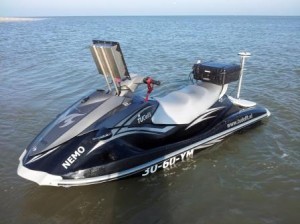
In a fantastic example of irony, a Dutch PhD candidate at TU Delft and researcher has spent the last three and a half years on a jet ski taking measurements along the Dutch coast to measure abnormal effects on currents caused by suppletion. Matthieu de Schipper will be awarded his PhD at TU Delft for his work measuring the aftereffects of a process wherein tons of sand are being deposited on Dutch beaches in order to preserve the coastline and compensate coastal erosion.
Created as a countermeasure to predicted rises in the sea-level due to global warming, de Schipper wanted to discover how large-scale suppletion affects the height variation in the seabed level along the coast. This was particularly timely, as substantial height variations can cause abnormal currents, endangering swimmers.
In an interview with TU Delft, de Schipper stated, “An important question prior to implementing a suppletion project is how the alongshore variability will evolve. For three and a half years we took measurements of the topography of a nourished Dutch beach – the Vlugtenburg beach at ‘s-Gravenzande. Every month we mapped the depth of water in an area of sea measuring 1.8 km by 1.2 km. We took measurements every 70 to 80 metres.”
To accomplish this, de Schipper used a Yamaha WaveRunner fitted with a survey system. Being a watersports and surfing enthusiast, the use of the ski was only common sense. He said, “That is what gave me the idea for carrying out the research in this way. The advantage of the jet-ski system is that it’s very flexible. It can be set up fairly quickly. Normally, measurements are taken from boats, but that’s much more time-consuming.”







